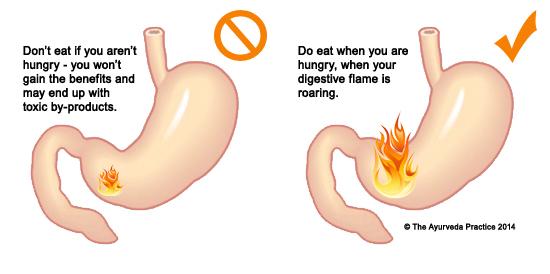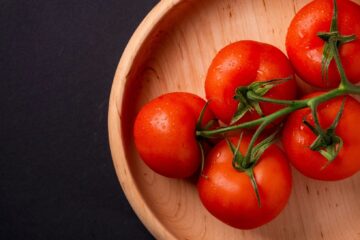“It comes back to the beginning” – the theme tune punch line from the fantastic TV series, The Bridge. If you haven’t seen it, you should! I’m singing the song for you now, you are just very lucky not to be able to hear me. It does indeed all come back to the beginning and in health, that beginning is digestion. If our digestion is poor we can suffer from immediate problems such as bloating, wind, heartburn, nausea, diarrhoea, constipation etc. It can also lead to a general sense of heaviness, lethargy, lack of energy and a sense of blockage in the body. If we allow the digestion to continue in a weak state, these more general symptoms can develop to a whole host of ailments and full blown diseases. If we keep our digestion in good shape, however, we feel light, energetic and strong. Our tissues are fully nourished and we have a good quantity of ojas, or resilience and immunity. With this knowledge and a few simple guidelines, we can avoid many pitfalls and stay healthy.
In Ayurveda, digestion is seen as the sum of many complex processes and is likened to a fire. This metaphor is fantastically useful. For a fire to burn wood effectively and create heat, the flame needs to be burning brightly. If it isn’t and it is just a glowing ember or a small flicker, you could put all the best logs on it, and nothing will happen. The logs will just get a little charred around the edges but no breakdown will occur and definitely no heat.
It’s the same with our digestion. Think about your digestion as being a small fire in the area of your stomach and duodenum. To be able to break down, absorb and assimilate the food you eat, this fire needs to be burning brightly. If it’s a good strong flame, you can eat your food in the knowledge that it will be digested well and you will be stronger for it and enjoy the energy that comes from it. If your digestive fire is strong, it means your stomach is ready for food and your digestive fluids are flowing.
 Let’s look at some things that might happen to this digestive fire.
Let’s look at some things that might happen to this digestive fire.
Eating when your digestive fire isn’t ready
How do we know our digestive fire is ready? We feel HUNGRY! Now this might seem very obvious and basic but you’d be surprised how many clients I talk to who don’t remember when they last felt hungry. In this society where food is readily available, all day every day, we eat for many different reasons. It may be because the clock says so, it may be habit, it may be due to boredom, anxiety or another emotion or it may be just because we crave something. What our bodies have evolved to do is to eat when our stomach is empty and our body is ready. We have a simple way of telling us when this is, it is hunger.
Experiment with feeling hungry before you eat anything, properly hungry. Experience the hunger pangs, the slightly gnawing pains in your stomach telling you that your digestive fire is roaring and ready to digest what you throw at it. It seems lots of people are scared of going there, don’t be. Make sure you DO eat when you are hungry, don’t let your body continue hungry for too long.
If you eat when your digestive fire isn’t ready, the digestive fire won’t be able to consume the food (like the logs on the dying embers) and our food won’t be digested properly, leaving us with less nutrition and the toxic by-products of incompletely digested food. This can lead to immediate problems such as bloating, wind, constipation etc. as well as generalised sense of heaviness, lethargy, lack of energy and a sense of blockage in the body.
Overloading your digestive fire
 For a flame in a fire place, there is an optimum amount of wood to add so that the wood burns well and enough heat is generated. If you put on too little, you don’t get the heat. If you put on too much, the flame gets swamped and the wood doesn’t burn. It is the same with our digestive fire. 2/3 capacity is the ideal amount of food to put in our stomachs. If we put in more than that, our digestive fire gets engulfed and our food doesn’t get digested.
For a flame in a fire place, there is an optimum amount of wood to add so that the wood burns well and enough heat is generated. If you put on too little, you don’t get the heat. If you put on too much, the flame gets swamped and the wood doesn’t burn. It is the same with our digestive fire. 2/3 capacity is the ideal amount of food to put in our stomachs. If we put in more than that, our digestive fire gets engulfed and our food doesn’t get digested.
How can we know when we are 2/3 full? The key is that we are still just a little bit hungry. It takes 20 minutes for our brain to register we have had enough so stop when you feel gently satisfied but are still a little bit hungry. Don’t finish what’s on your plate when you get to this stage. It is better to waste what is left on the plate than what is already in your stomach.
Drowning out your digestive fire
Sip water gradually throughout the day. This is very important advice on many levels and particularly so when it comes to digestion. If we drop a few drops of water on a flame, what happens? It flickers a little and keeps burning. If you chuck a bucket of water on it, it goes out. Use this analogy to understand why it is important to sip water on-off rather than downing a large glass of water all at once.
Keep your digestive fire strong using the following guidelines:
- Eat only when you are hungry. When you experience hunger you should have a proper meal. Even if the time is other than when you expect to feel hungry.
- Never over-eat, your stomach should feel gently satisfied and never full (about 2/3 of capacity is ideal). Don’t finish everything on your plate if you are satisfied.
- Sip drinks gradually, do not gulp down glasses.
- Drink room temperature or preferably warmer water – the ideal is comfortably hot water.
- Cook with herbs and spices (they make your food easier to digest and absorb). Ginger is especially good for digestion, but others include black pepper, cumin, coriander, mint, basil, oregano, rosemary and thyme.
- Eat warm or room temperature food, never straight from the fridge.
Experiment – you’ll feel the effects straight away!
Till next time, take care of yourselves.
Kate
Author: Kate Siraj, Ayurvedic Practitioner, BSc Ayurveda, MChem (Oxon), MAPA.
© The Ayurveda Practice





16 Comments
Omprakash Bera · April 17, 2014 at 11:45
Hello,
Interesting blog! These pictures are really great for understanding the entire digestive functions. Details about digestive fire and guidelines are very much helpful for me. Thank you so much for providing this information with us.
Pantry essentials - The Ayurveda Practice · January 29, 2016 at 08:30
[…] THAN: modern wheat flour. Spelt is much easier to digest than modern wheat. Stocking both wholegrain and white spelt flour means you can use it for […]
Smoothies and juices – choose wisely - The Ayurveda Practice · March 15, 2016 at 14:17
[…] to the smoothie, it will inevitably be cold and this will reduce the power of your digestion (see here for why). You will be consuming all these fabulous vitamins and nutrients but if your digestion is […]
Avoid disease by keeping free from āma – the number 1 root of disease - The Ayurveda Practice · May 6, 2016 at 11:10
[…] Learn about your digestive fire by reading all about it here. […]
Enjoy your Christmas roast with impunity this winter - The Ayurveda Practice · December 14, 2016 at 10:22
[…] Digestive fire increases in the winter, so follow it. Eat more if your body is asking for it. If you need it, you will naturally build up a little healthy reserve in the body which will then fall away in spring. […]
Banish those sugar cravings - The Ayurveda Practice · March 17, 2017 at 14:26
[…] food which you can confidently include in your diet (best eaten by itself as it can cause digestive problems and āma if eaten with other […]
Importance of Digestive Fire in Ayurved – Vandana Sandhir · April 17, 2017 at 04:45
[…] Photo credit: Digestive Fire, Stomach Capacity […]
Add spices, add flavour, improve nutrition - The Ayurveda Practice · October 13, 2017 at 11:58
[…] put the most nutritious food into your mouth but to get the goodness out of it, it needs to be well digested. There is one simple way to make sure this happens; add herbs and spices to your food. Plus, […]
You’re not what you eat, you’re what you digest - The Ayurveda Practice · June 22, 2018 at 13:23
[…] all woods burn the same in a fire, do they? The same can be said about foods we put in our ‘digestive fire’. Some burn (or digest) easily, some are more difficult. This important aspect of food often […]
Conquer stress with my five favourite adaptogens - The Ayurveda Practice · May 3, 2019 at 16:29
[…] and lack of energy. Less well-known are the proven links to a weakened immune system, digestive issues, diabetes and reproductive problems. In Ayurveda, stress is seen to reduce ojas (the […]
Understanding your health – in pictures - The Ayurveda Practice · May 10, 2019 at 07:43
[…] a guide to your likely levels of āma (toxicity) in the 7 tissues and the digestive tract […]
Boost immunity, reduce stress, stay strong - The Ayurveda Practice · March 13, 2020 at 14:25
[…] gently cooked food (not boiled into oblivion but maybe steamed, sauted or stir-fried) so that the digestive fire can break it down and assimilate it […]
Avoid these combinations (and ignore the myths) - The Ayurveda Practice · November 20, 2020 at 15:31
[…] vaguely interested in Ayurveda will know that digestion is key to health. Modern medical practitioners are also now realising this, with a widening range […]
Cool inflammation with the ‘quick purge’ - The Ayurveda Practice · February 14, 2021 at 09:53
[…] out the excess doshas from the digestive tract (during the […]
Manage your channel blockers - The Ayurveda Practice · June 29, 2021 at 16:27
[…] when digestive fire is strong. Abhishyandi foods should be eaten only when our digestive fire is strong. This means […]
Fasting - what does Ayurveda say? - The Ayurveda Practice · February 2, 2024 at 13:10
[…] The bare minimum of fasting recommended for everyone apart from those who are severely depleted is to fast between meals until we experience proper hunger; that sensation of an empty stomach, a lightness to the body, clear burps and maybe a first rumble. This gives us a good length of time between meals for full digestion and assimilation and to maintain a well-functioning digestive fire. […]